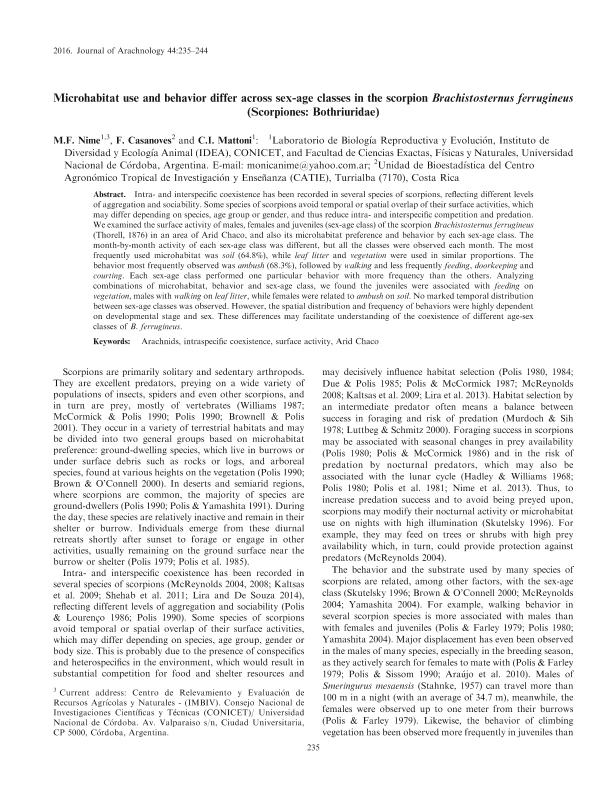Mostrar el registro sencillo del ítem
dc.contributor.author
Nime, Mónica Fernanda

dc.contributor.author
Casanoves, Fernando

dc.contributor.author
Mattoni, Camilo Ivan

dc.date.available
2018-08-21T20:10:03Z
dc.date.issued
2016-08
dc.identifier.citation
Nime, Mónica Fernanda; Casanoves, Fernando; Mattoni, Camilo Ivan; Microhabitat use and behavior differ across sex-age classes in the scorpion Brachistosternus ferrugineus (Scorpiones: Bothriuridae); American Arachnological Society; Journal of Arachnology; 44; 2; 8-2016; 235-244
dc.identifier.issn
0161-8202
dc.identifier.uri
http://hdl.handle.net/11336/56440
dc.description.abstract
Intra- and interspecific coexistence has been recorded in several species of scorpions, reflecting different levels of aggregation and sociability. Some species of scorpions avoid temporal or spatial overlap of their surface activities, which may differ depending on species, age group or gender, and thus reduce intra- and interspecific competition and predation. We examined the surface activity of males, females and juveniles (sex-age class) of the scorpion Brachistosternus ferrugineus (Thorell, 1876) in an area of Arid Chaco, and also its microhabitat preference and behavior by each sex-age class. The month-by-month activity of each sex-age class was different, but all the classes were observed each month. The most frequently used microhabitat was soil (64.8%), while leaf litter and vegetation were used in similar proportions. The behavior most frequently observed was ambush (68.3%), followed by walking and less frequently feeding, doorkeeping and courting. Each sex-age class performed one particular behavior with more frequency than the others. Analyzing combinations of microhabitat, behavior and sex-age class, we found the juveniles were associated with feeding on vegetation, males with walking on leaf litter, while females were related to ambush on soil. No marked temporal distribution between sex-age classes was observed. However, the spatial distribution and frequency of behaviors were highly dependent on developmental stage and sex. These differences may facilitate understanding of the coexistence of different age-sex classes of B. ferrugineus.
dc.format
application/pdf
dc.language.iso
eng
dc.publisher
American Arachnological Society

dc.rights
info:eu-repo/semantics/openAccess
dc.rights.uri
https://creativecommons.org/licenses/by-nc-sa/2.5/ar/
dc.subject
Arachnids
dc.subject
Arid Chaco
dc.subject
Intraspecific Coexistence
dc.subject
Surface Activity
dc.subject.classification
Otras Ciencias Biológicas

dc.subject.classification
Ciencias Biológicas

dc.subject.classification
CIENCIAS NATURALES Y EXACTAS

dc.title
Microhabitat use and behavior differ across sex-age classes in the scorpion Brachistosternus ferrugineus (Scorpiones: Bothriuridae)
dc.type
info:eu-repo/semantics/article
dc.type
info:ar-repo/semantics/artículo
dc.type
info:eu-repo/semantics/publishedVersion
dc.date.updated
2018-08-17T14:30:24Z
dc.journal.volume
44
dc.journal.number
2
dc.journal.pagination
235-244
dc.journal.pais
Estados Unidos

dc.journal.ciudad
Nueva York
dc.description.fil
Fil: Nime, Mónica Fernanda. Consejo Nacional de Investigaciones Científicas y Técnicas. Centro Científico Tecnológico Conicet - Córdoba. Instituto de Diversidad y Ecología Animal. Universidad Nacional de Córdoba. Facultad de Ciencias Exactas Físicas y Naturales. Instituto de Diversidad y Ecología Animal; Argentina
dc.description.fil
Fil: Casanoves, Fernando. Unidad de Bioestadística del Centro Agronómico Tropical de Investigación y Enseñanza; Costa Rica
dc.description.fil
Fil: Mattoni, Camilo Ivan. Consejo Nacional de Investigaciones Científicas y Técnicas. Centro Científico Tecnológico Conicet - Córdoba. Instituto de Diversidad y Ecología Animal. Universidad Nacional de Córdoba. Facultad de Ciencias Exactas Físicas y Naturales. Instituto de Diversidad y Ecología Animal; Argentina
dc.journal.title
Journal of Arachnology

dc.relation.alternativeid
info:eu-repo/semantics/altIdentifier/doi/https://dx.doi.org/10.1636/J15-63
dc.relation.alternativeid
info:eu-repo/semantics/altIdentifier/url/http://www.bioone.org/doi/10.1636/J15-63
Archivos asociados
